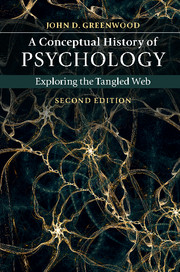Book contents
- Frontmatter
- Contents
- Preface
- 1 History, science, and psychology
- 2 Ancient Greek science and psychology
- 3 Rome and the medieval period
- 4 The scientific revolution
- 5 The Newtonian psychologists
- 6 Physiology and psychology
- 7 Theories of evolution
- 8 Psychology in Germany
- 9 Psychology in America: the early years
- 10 Functionalism, behaviorism, and mental testing
- 11 Neobehaviorism, radical behaviorism, and problems of behaviorism
- 12 The cognitive revolution
- 13 Abnormal and clinical psychology
- Epilogue: the past and future of scientific psychology
- Index
- References
13 - Abnormal and clinical psychology
Published online by Cambridge University Press: 05 September 2015
- Frontmatter
- Contents
- Preface
- 1 History, science, and psychology
- 2 Ancient Greek science and psychology
- 3 Rome and the medieval period
- 4 The scientific revolution
- 5 The Newtonian psychologists
- 6 Physiology and psychology
- 7 Theories of evolution
- 8 Psychology in Germany
- 9 Psychology in America: the early years
- 10 Functionalism, behaviorism, and mental testing
- 11 Neobehaviorism, radical behaviorism, and problems of behaviorism
- 12 The cognitive revolution
- 13 Abnormal and clinical psychology
- Epilogue: the past and future of scientific psychology
- Index
- References
Summary
Histories of abnormal and clinical psychology tend to be decidedly presentist and generally represent the history of psychological theory and therapy as a progression from superstitious theories of spirit possession and brutal persecution to contemporary scientific theories and humane treatments (Sedgewick, 1982). Often this is based upon little more than condescending assumptions about earlier peoples. For example, when Neolithic skulls were discovered with holes in them, the French neurophysiologist Paul Broca opined that they must have been made “in order to liberate evil spirits” (Ackerknecht, 1982, pp. 8–9), a representation still repeated in some histories of psychology. Yet it is just as likely that such holes were the product of early forms of trepanning, the removal of part of the skull to reduce swelling of the brain caused by injury through war or hunting.
As noted earlier, the ancient and medieval peoples were rather more sophisticated and humane, at least relative to their times, than they usually are given credit for. They recognized depression, mania, and hysteria and attributed most psychological disorders to neural causes. Their psychological treatments, which were usually based upon holistic principles derived from Hippocrates and Galen, included fresh air, relaxation, dieting, and music, as well as bloodletting and purgation.
From early Roman times, laws governed the treatment of the psychologically disturbed and provided for family or community guardianship of persons designated as “insane” or “mad” (Neaman, 1975). These laws recognized that such persons were not legally responsible for their actions, because of their diminished or defective powers of reasoning (Maher and Maher, 1985a; Neugebauer, 1978). Institutions devoted to the treatment of the psychologically disturbed were set up in medieval cities such as Baghdad, Valencia, and London, and the common law of many medieval European states included protections for them (Schoeneman, 1977).
Those deemed insane were generally cared for by their families or legally appointed guardians. They were occasionally beaten – the common law of England allowed people to beat their mad relatives (Allderidge, 1979) – and those deemed dangerous were restrained or imprisoned. Although, no doubt many were persecuted and exploited, their treatment was not especially cruel relative to the conditions of the time.
- Type
- Chapter
- Information
- A Conceptual History of PsychologyExploring the Tangled Web, pp. 495 - 539Publisher: Cambridge University PressPrint publication year: 2015



